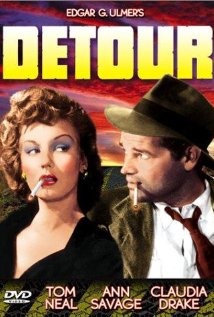Is Detour just a bad dream? Or a masochistic reverie dredged up out of the sumps of self-loathing? Long before setting out on the road trip that took such a disastrous turn, Tom Neal was a picky eater at life’s banquet. Pounding the ivories in a Manhattan nitery, he sulks that his talent goes unappreciated (when a drunk tips him a ten-spot, it’s ‘a piece of paper crawling with germs’). He sabotages his rapturous renditions of Chopin and Brahms waltzes with a left-handed boogie-woogie beat. When his girl, the club’s shantoozie, tells him that he’ll make it to Carnegie Hall ‘someday,’ he snaps back, ‘Sure, as a janitor. Maybe I’ll make my debut in the basement,’ and ‘Yeah, someday – if I don’t get arthritis first.’ Neal’s lousy with what we now call issues.
When his fiancée heads to Los Angeles to try for the lush life, he lets her go, then, suddenly lonesome, decides to hitch out to the coast. In Arizona, he thumbs a ride from a pill-popping driver (Edmund McDonald) with scratches on his wrist from tussling with a ‘wild animal’ – a woman he had picked up in Louisiana. When Neal takes over the wheel during a rainstorm, McDonald up and dies – and conks his head on a rock as he slumps out the passenger door. Looks bad. Since he casts himself as eternal victim, Neal, though blameless, guiltily drags the body into the desert and assumes its identity (along with car and wallet). Later, at a gas station, he offers a lift to another thumb-jockey (Ann Savage), even though she looks like she ‘just got thrown off the crummiest freight train in the world.’ (Does the phrase ‘self-destructive’ strike a familiar note?) In fact, she’s none other than the beast who sank her claws into the deceased – and plans to make an even bigger feast out of Neal….
The stubble on Neal’s unshaved chin can’t disguise his pouty, pretty-boy looks, and he proves just right as this callow, ill-starred loser (a better actor would have added superfluous dimensions). If he and his self-absorbed predicament start to wear a little thin, it ceases to matter when Savage arrives halfway through to give a performance that beggars all description. Owing either to Ulmer’s or her own genius (or to exigent production values), her hard face stays stripped of glamor – when she does slap on the war paint, the effect is primitive, alarming, with eyebrows that looked slashed on with a stiletto under an unkempt riot of hair. She starts off slowly, until, supposedly dozing in the shotgun seat, her eyes fly open to size up and devour Neal. It’s the most terrifying instant in Detour. From then on in, she’s all shrew all the time, drunk or sober, intimidating or seductively manipulative. Thus Savage’s Vera entered film history as the hardest-boiled of its femmes fatales. And Neal never knew what hit him.
Insolently original – a classic in a class by itself – Detour is by no stretch of the imagination a conventional masterpiece (if masterpieces can be counted as conventional). It shows evidence of starting out to be something – a longer, more fully developed movie – quite different from what it ended up . Groundwork gets laid for developments that never come to pass. What seems to be intended as the plot’s centerpiece – a scheme to pass Neal off as McDonald, the lost scion of a wealthy family – comes to nothing. As does Savage’s ominous cough, a clue to her subsequent indifference (‘I’m on my way anyhow’) to that ‘perfume Arizona hands out free to murderers.’
Somewhere along the way, Detour ran out of time, or money, or film stock, and was cobbled together out of footage already in the can, with the aid of peculiar voice-overs (in the last-ditch manner of The Magnificent Ambersons or My Son John). Against all odds, it still worked, and remains one of the best known and most unforgettable titles in the film noir canon, a stunningly effective piece of work that manages to encapsulate, in 67 minutes, all the inchoate angst that informs the cycle. It may have been an accident, but it’s the kind of accident you can’t peel your eyes off of.
When the noir cycle began to coalesce in the early 1940s, it looked like it was going to take the high road of starry, big-budget prestige productions (The Maltese Falcon, I Wake Up Screaming, The Glass Key, Laura, Double Indemnity, Mildred Pierce). Edgar G. Ulmer’s Detour took the low road. A Poverty-Row production empty of box-office names, it was shot on a few cheap sets in a matter of days. But it sweated off a raw power that other alert film-makers working on the fringes of the industry were quick to emulate; the next few years would see Fall Guy, The Guilty, Suspense, Violence, I Wouldn’t Be In Your Shoes, Decoy (the pick, along with Detour, of this particular litter) – all done with wannabes or has-beens in cast and crew, visually often ugly (the murky lighting more a matter of necessity than moody esthetic choice). It was often inspired movie-making on the most frayed of shoestring budgets.
And yet, with a few exceptions, this second-feature slot was the niche into which film noir would settle until it ran its course in the late 1950s. Which raises a question: Without Detour paving the way for quick-and-dirty, sensational fodder to fill up double bills – B-movies that the suits in the front offices didn’t much care about and so paid little attention to – would the noir cycle have been but a brief flash in the pan? Would it have stayed the passion only of a handful of French cineastes? Would it have amounted to a cycle at all? The debt owed to Detour may be greater than acknowledged.
Written by B Macv

